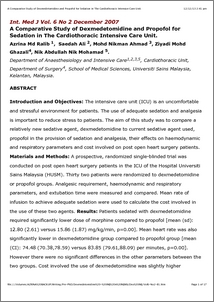Md Ralib, Azrina and Ali, Saedah and Ahmad, Mohd Nikman and Mohd Ghazali, Ziyadi and Nik Mohamad, Nik Abdullah
(2007)
A comparative study of dexmedetomidine and propofol for
sedation in the cardiothoracic intensive care unit.
International Medical Journal Malaysia, 6 (2).
pp. 1-17.
ISSN 1823-4631
![[img]](http://irep.iium.edu.my/style/images/fileicons/application_pdf.png)  Preview |
|
PDF (A comparative study of dexmedetomidine and propofol for sedation in the cardiothoracic intensive care unit)
- Published Version
Download (258kB)
| Preview
|
Abstract
Introduction and Objectives: The intensive care unit (ICU) is an uncomfortable and stressful environment for patients. The use of adequate sedation and analgesia is important to reduce stress to patients. The aim of this study was to compare a relatively new sedative agent, dexmedetomidine to current sedative agent used, propofol in the provision of sedation and analgesia, their effects on haemodynamic and respiratory parameters and cost involved on post open heart surgery patients. Materials and Methods: A prospective, randomized single-blinded trial was conducted on post open heart surgery patients in the ICU of the Hospital Universiti Sains Malaysia (HUSM). Thirty two patients were randomized to dexmedetomidine or propofol groups. Analgesic requirement, haemodynamic and respiratory
parameters, and extubation time were measured and compared. Mean rate of
infusion to achieve adequate sedation were used to calculate the cost involved in
the use of these two agents. Results: Patients sedated with dexmedetomidine
required significantly lower dose of morphine compared to propofol [mean (sd):
12.80 (2.61) versus 15.86 (1.87) mg/kg/min, p=0.00]. Mean heart rate was also
significantly lower in dexmedetomidine group compared to propofol group [mean (CI): 74.48 (70.38,78.59) versus 83.85 (79.61,88.09) per minutes, p=0.00]. However there were no significant differences in the other parameters between the two groups. Cost involved the use of dexmedetomidine was slightly higher compared to propofol (RM 9.57 versus RM8.94 per hour). Discussion and
Conclusions: Dexmedetomidine is comparable to propofol in the provision of
sedation, and its effect on haemodynamic and respiratory parameters. However it
has added advantages in the provision of analgesia, and caused a significant
reduction in heart rate. This is beneficial in these patients by reducing myocardial oxygen demand, and hence subsequent ischaemia and infarction. However, further larger studies are needed to evaluate the effect of dexmedetomidine on perioperative cardiac morbidity and mortality.
Actions (login required)
 |
View Item |


 Download Statistics
Download Statistics Download Statistics
Download Statistics